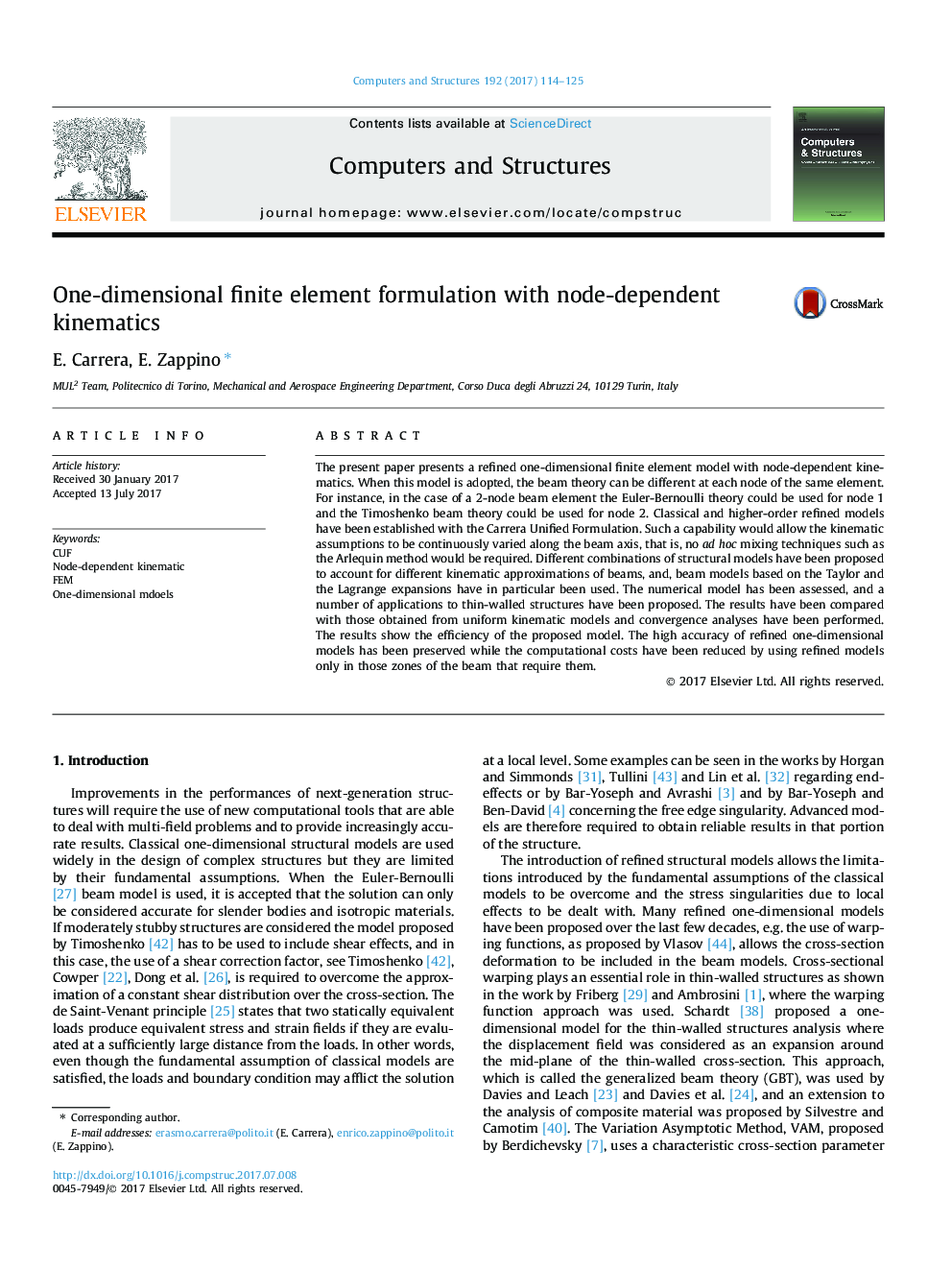| کد مقاله | کد نشریه | سال انتشار | مقاله انگلیسی | نسخه تمام متن |
|---|---|---|---|---|
| 4965613 | 1448453 | 2017 | 12 صفحه PDF | دانلود رایگان |
عنوان انگلیسی مقاله ISI
One-dimensional finite element formulation with node-dependent kinematics
ترجمه فارسی عنوان
فرمول عنصر محدود یک بعدی با سینماتیک وابسته به گره
دانلود مقاله + سفارش ترجمه
دانلود مقاله ISI انگلیسی
رایگان برای ایرانیان
ترجمه چکیده
مقاله حاضر یک مدل عنصر محدود یک بعدی تصحیح شده با سینماتیک وابسته به گره ارائه می دهد. هنگامی که این مدل پذیرفته شود، نظریه پرتو در هر گره یک عنصر می تواند متفاوت باشد. برای مثال، در مورد یک عنصر پرتو 2 گره، نظریه اویلر-برنولی برای گره 1 می تواند مورد استفاده قرار گیرد و برای گره 2 می توان تئوری پرتو تیموشنکو را استفاده کرد. مدل های تصحیح شده کلاسیک و مرتبه بالاتر با کاررا وحدت فرمولاسیون چنین توانایی اجازه می دهد که فرضیه های سینماتیکی در امتداد محور پرتو به طور مداوم تغییر پیدا کنند، یعنی هیچ تکنیک اختلاط مجزا مانند روش آرکلین مورد نیاز نیست. ترکیبی از مدل های ساختاری برای تقریب های مختلف سینماتیک پرتوها پیشنهاد شده است و مدل های پرتو بر اساس تیلور و لاگرانژ بطور خاص استفاده شده است. مدل عددی بررسی شده است و تعدادی از کاربردهای ساختارهای نازک دیواره پیشنهاد شده است. نتایج به دست آمده از مدلهای سینماتیکی یکنواختی مقایسه شده است و تجزیه و تحلیل همگرایی انجام شده است. نتایج نشان می دهد که کارایی مدل پیشنهاد شده است. دقت بالای مدلهای یکپارچه تصفیه شده حفظ شده است، در حالی که هزینه های محاسباتی با استفاده از مدل های تصفیه شده تنها در مناطقی از پرتو مورد نیاز آنها کاهش یافته است.
موضوعات مرتبط
مهندسی و علوم پایه
مهندسی کامپیوتر
نرم افزارهای علوم کامپیوتر
چکیده انگلیسی
The present paper presents a refined one-dimensional finite element model with node-dependent kinematics. When this model is adopted, the beam theory can be different at each node of the same element. For instance, in the case of a 2-node beam element the Euler-Bernoulli theory could be used for node 1 and the Timoshenko beam theory could be used for node 2. Classical and higher-order refined models have been established with the Carrera Unified Formulation. Such a capability would allow the kinematic assumptions to be continuously varied along the beam axis, that is, no ad hoc mixing techniques such as the Arlequin method would be required. Different combinations of structural models have been proposed to account for different kinematic approximations of beams, and, beam models based on the Taylor and the Lagrange expansions have in particular been used. The numerical model has been assessed, and a number of applications to thin-walled structures have been proposed. The results have been compared with those obtained from uniform kinematic models and convergence analyses have been performed. The results show the efficiency of the proposed model. The high accuracy of refined one-dimensional models has been preserved while the computational costs have been reduced by using refined models only in those zones of the beam that require them.
ناشر
Database: Elsevier - ScienceDirect (ساینس دایرکت)
Journal: Computers & Structures - Volume 192, November 2017, Pages 114-125
Journal: Computers & Structures - Volume 192, November 2017, Pages 114-125
نویسندگان
E. Carrera, E. Zappino,
